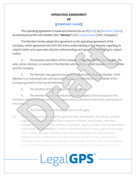Crafting an Effective E-Commerce Privacy Statement: A Comprehensive Guide
As an e-commerce business owner, protecting your shoppers' privacy should be at the top of your to-do list. One effective way to accomplish that,...
6 min read
LegalGPS : July 26, 2024 at 10:05 AM
Navigating the sphere of e-commerce may sometimes feel like learning a foreign language. That's why, dear reader, we’re here to demystify it for you. Sit back, grab a cup of coffee, and buckle up for our journey across the landscape of “E-commerce Terms & Conditions”.

Legal GPS templates are drafted by top startup attorneys and fully customizable.
Chances are, if you're here, then you're scratching your head over what e-commerce terms & conditions are and why they matter. Don't worry, we've got your back. Grab your coffee and let's have a little chat about the basics of e-commerce terms & conditions (T&Cs) and how you can start crafting your very own.
At its core, e-commerce terms & conditions are legal agreements that outline the relationship between your online business and your customers. T&Cs help both parties understand what they can expect from each other, setting expectations and providing the rules for using your website and services.
So why are T&Cs super important for your e-commerce business?
They protect you and your customers
They clarify each party's rights and responsibilities
They offer practical guidance on the use of your website
They help prevent potential legal disputes down the line
To make things easier and actionable for you, let's walk through the main components typically found in e-commerce T&Cs:
Acceptance of Terms: Clearly state that users accept your T&Cs just by accessing or using your website or purchasing products from you.
Description of Services: Make sure to describe your website, products, or services accurately and in language that any layperson can understand easily.
Payment Terms: Clarify how customers pay for your products, the payment methods accepted, billing process, and refund policies in cases involving disputes, cancellations, or fraud.
Shipping & Delivery: Include a shipping policy mentioning the carriers, delivery times, delivery costs, and any exceptions (like shipping outside your country).
Returns & Refunds: Explain how customers can return or exchange products, the conditions for accepting returns, the refund process, and timeframes.
Use of Your Website: Include any rules or restrictions on using your website, accounts, and user obligations.
Copyright & Intellectual Property: Establish that your website design, content, and products belong to you or the rightful owner, and state the legal implications of unauthorized use.
Limitation of Liability: Prevent holding your business liable for any indirect or consequential loss or damage, except the direct loss or damage that may arise through your fault.
Governing Law: Specify the jurisdiction that will govern your terms and conditions, usually the country or state where your business is located.
With these components, you'll have a solid starting point to understand the purpose and structure of e-commerce T&Cs.
Evaluate your e-commerce business model and identify the components relevant to your store.
List out your main T&C sections using the list above as a guide.
Share your list with team members, get feedback, and identify any additional sections needed.
Start drafting your T&Cs by describing your business operations and user interaction.
Revise and refine your T&Cs to ensure clarity, accuracy, and comprehensiveness.
Don't worry if this all seems a bit overwhelming. Use our guidelines to start drafting, and remember, Legal GPS is here to help. If you need more assistance, check out our range of professionally drafted e-commerce T&C templates tailored for businesses like yours.

Protect your business with our complete legal subscription service, designed by top startup attorneys.
"Why do I need E-Commerce Terms & Conditions?", you ask. Great question, my entrepreneurial friend! E-commerce T&Cs are not just a formality; they're your first line of defense in a world of online business where things can get messy.
Running an e-commerce store can sometimes feel like opening Pandora's box, between dealing with customer disputes, data privacy issues, logistics challenges, and intellectual property theft. But don’t you worry, having thoughtfully designed T&Cs can shield you from these potential downhill.
Here's why you absolutely, positively NEED detailed E-commerce Terms & Conditions:
Protect Your Intellectual Property: E-commerce T&Cs offers a protective layer to your copyrights, trademarks, patents, etc. Your T&Cs should state that all content on your website, including text, logos, image, is wholly owned or licensed by you. The users are only allowed to use this intellectual property as permitted by you.
Limit Your Legal Liability: By making it evident that you provide your products or services "as is" and are not responsible for third parties, you limit your liability. You protect your business from claims arising out of user's reliance on information on your website, interruptions in website availability, etc. Detail this in your T&Cs to avoid expensive legal suits.
Set User Behavior Expectations: T&Cs provide a framework for acceptable behavior on your website. This would generally cover aspects like not uploading offensive content, not using the site for any illegal activities, not interfering with its security features, etc.
Manage User Accounts and Dispute Resolution: If you offer user accounts, detailed T&Cs can guide you in managing them effectively. It comes in handy during moments of disagreements between you and the users. Clear T&Cs offer a guideline on how disputes will be resolved, including your preferred mode of conflict resolution (mediation, arbitration, court) and the governing law (the jurisdiction in which any legal actions would be taken).
Ready to make these T&Cs on your own? Here are some actionable steps:
Protecting Intellectual Property: List out all the types of content you have on your website that should be protected, like text, logos, product photos, etc. Now mention in your T&Cs this content belongs to you and cannot be used without your permission.
Limiting Liability: Describe the extent to which your website, products, or services can be relied upon. For instance, if there's a service disruption, state that you can't be held responsible for any loss incurred.
Setting User Behaviour: Identify activities you think are acceptable on your website, and those that aren't, and detail them out in this section.
Dispute Resolution: Figure out how would you like to resolve disputes (court proceedings, arbitration, mediation?) and under what state/country laws. Include these details in your T&Cs.
Remember, your e-commerce T&Cs should reflect the way you run your business. Customization is key. Don't just copy-paste a generic template and call it a day. If in doubt, reach out to us at Legal GPS for some template brainstorming and get your perfect, bulletproof T&Cs ready!

E-commerce T&Cs are typically broken down into different sections, each dealing with a specific topic. We’ve laid out some of the most common sections found in e-commerce T&Cs:
Acceptance of the T&Cs: This section mentions that users accept your T&Cs by their actions (like making a purchase).
Description of the service: Here, you detail what service or product you're providing.
Payment terms: This includes how prices are set, what payment methods are available, billing procedure, etc.
Delivery and return policy: Detailed explanation of your shipping, delivery methods, timelines, and return and refund policies.
Account use: If you offer user accounts, you'd cover rules about account creation, suspension, and termination.
Intellectual property rights: Very important—this affirms what belongs to you and is not for misuse.
Get Your E-commerce Terms & Conditions Template
with a Legal GPS Subscription
Drafting your own e-commerce T&Cs might seem like a steep mountain to climb, but breaking it down into manageable steps can make it a far easier job. Here's how you do it:
Introduction: Kick off your T&Cs with a brief introduction outlining what your T&Cs intend to cover. Basic definitions can be included here, such as what your site or business refers to, who the "user" or "buyer" is etc.
For example,
"Welcome to [Your Online Store], a website located at [your website] and operated by [Your Company]. We offer [describe your products/services]."
Acceptance of Terms: It's crucial to state explicitly that by using your website's services, users agree to abide by your terms. Include a statement such as,
"By using our site and services, you agree to our Terms & Conditions. If you don't agree with them, unfortunately, we must ask you not to use our site."
Describe Your Services: Provide a detailed description of the goods or services you offer in plain language. This isn't the place to be mysterious or vague. Make sure your customers know precisely what they're getting.
Account Registration: If you offer user accounts, specify the details of account creation, security, user responsibilities and what would lead to account restrictions or termination. Lay down your criteria:
"When creating an account, you agree to provide true and accurate information and update it as necessary. You are responsible for maintaining the confidentiality of your account and password…"
Payment Terms: Be clear on how prices are determined, what forms of payment are accepted, what the billing process looks like, and any conditions related to discounts, promo codes or sales.
Delivery and Returns: Will you be shipping goods? Include all relevant details like shipping methods, timelines and costs. And of course, clearly lay out your return, refund and exchange policies too.
"We offer standard and express shipping. Orders are processed within 3 business days…”.
Intellectual Property: This is particularly important in the e-commerce world. Affirm that your website, logo, content, etc., are your property and are protected by copyright and other laws.
Limitations of Liability: Include this section to limit your liability in the event that issues arise with your goods or services.
Governing Law: Last but not least, state the jurisdiction that applies to your T&Cs. It generally tends to be the location of your business.
“These terms will be governed by and construed in accordance with the laws of [Your Location]…”
So, while this might seem a bit of a task, breaking it down like this can make crafting your own e-commerce T&Cs quite a manageable job. You aren't just filling out a form, you're building a legally sound foundation for your business. And remember, Legal GPS is here to assist. If things get too jargon-heavy or confusing, don't hesitate to check out our pre-made, lawyer-reviewed e-commerce T&Cs templates!
Get Legal GPS's E-commerce Terms & Conditions Template Now

Protect your business with our complete legal subscription service, designed by top startup attorneys.

As an e-commerce business owner, protecting your shoppers' privacy should be at the top of your to-do list. One effective way to accomplish that,...

If you're a business owner looking for ways to expand your business reach, entering into a distribution agreement could be just the ticket. It may...

When running a business, it’s important to make sure all your legal bases are covered. One key area often overlooked is understanding the role and...